
The 3DO Interactive Multiplayer, also referred to as simply 3DO, is a home video game console developed by The 3DO Company. Conceived by entrepreneur and Electronic Arts founder Trip Hawkins, the 3DO was not a console manufactured by the company itself, but a set of specifications, originally designed by Dave Needle and RJ Mical of New Technology Group, that could be licensed by third parties. Panasonic produced the first models in 1993, and further renditions of the hardware were released afterwards by GoldStar, Sanyo, Creative Labs, and Samsung Electronics in 1997.

Brian Moriarty is an American video game developer who authored three of the original Infocom interactive fiction titles, Wishbringer (1985), Trinity (1986), and Beyond Zork (1987), as well as Loom (1990) for LucasArts.
Panasonic M2, earlier known as 3DO M2, is a multimedia terminal and cancelled video game console. It was initially developed by The 3DO Company as a peripheral chip for the 3DO Interactive Multiplayer before turning into a standalone system. In January 1996, the technology was acquired by Matsushita (Panasonic) who continued development before cancelling the game console altogether in 1997. The M2 technology was then incorporated into commercial-oriented devices including a Konami arcade board and in interactive kiosks.

Primal Rage is a fighting game developed and released by Atari Games for arcades in 1994. The game takes place on a post-apocalyptic version of Earth called "Urth". Players control one of seven prehistoric beasts, that battle each other to determine the planet's fate. Matches feature many of the conventions of fighting games from the era, including special moves and gory finishing maneuvers. Ports were released for home video game consoles and personal computers. Efforts to perfectly emulate the arcade original have been unsuccessful due to the use of an unusual copy protection method. Toys, comics, a novel and other merchandise tie-ins were produced. More than 1.5 million copies of the game were sold.
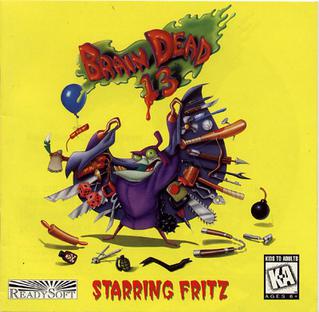
Brain Dead 13 is an interactive movie video game developed and originally published in North America by ReadySoft on 15 December 1995 and in Europe by Empire Interactive on the same year for MS-DOS. Unlike Dragon's Lair and Space Ace, which began as laserdisc arcade games, it was only released for personal computers and video game consoles. In the game, players assume the role of young computer expert Lance Galahad to defeat Dr. Nero Neurosis at his castle and its residents. Its gameplay is primarily presented through the use of full-motion video (FMV).
Maximum Surge is a cancelled video game by Digital Pictures. Planned for release in 1996 for the 3DO, Mac, PC and Sega Saturn, it was to feature full-motion video in the same way that many of Digital Pictures' releases of the time did. The game's 90 minutes of video footage starred Walter Koenig and Yasmine Bleeth, was directed by William Mesa, and was written by J. Garrett Glover and Charlie Ogden.
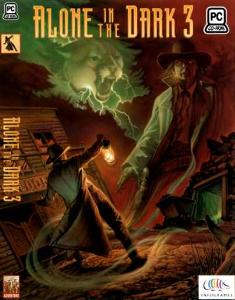
Alone in the Dark 3 is a 1995 survival horror video game developed and published by Infogrames Multimedia. It is the third installment of the Alone in the Dark video game series. The video game was released for MS-DOS in 1995. It was ported to the PC-98 later that year. Versions for Windows and Mac OS were also released in 1996.

Family Feud is a video game series based on the Family Feud TV game show. It began with ShareData's 1987 release on the Apple II and Commodore 64 consoles. In 1990 GameTek released a version on the Nintendo Entertainment System. GameTek later released four more Feud games for the Super NES, Sega Genesis, 3DO, and MS-DOS between 1993 and 1995. Hasbro Interactive, Global Star, and Ubisoft have also released versions starting in 2000.
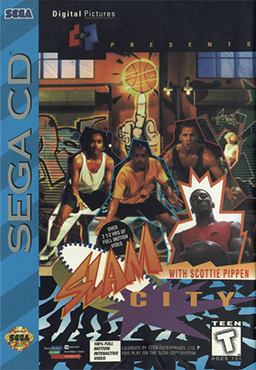
Slam City with Scottie Pippen is the first FMV basketball video game. It was developed by Digital Pictures for the PC and CD-ROM-based video game consoles such as the Sega CD. Scottie Pippen stars in the game, and performed the theme song. Ron Stein, who had previously directed the video footage for Prize Fighter, directed the video footage for the game. A 3DO Interactive Multiplayer version was announced but never released.

Rocket Science Games was a video game developer and publisher that created games for consoles and personal computers from 1993 to 1997. The company released Loadstar: The Legend of Tully Bodine, Cadillacs and Dinosaurs: The Second Cataclysm, Wing Nuts: Battle in the Sky, Rocket Jockey, and Obsidian. The Space Bar was the final game developed by Rocket Science. After the company folded, it was published by SegaSoft. Six additional games were never completed.
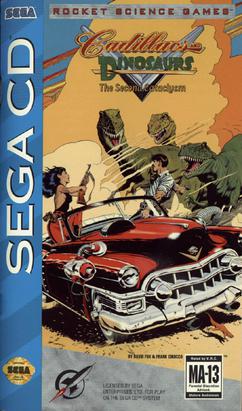
Cadillacs and Dinosaurs: The Second Cataclysm is a rail shooter video game made by Rocket Science Games based on the comic book Xenozoic Tales. The game was originally released in 1994 for Sega CD and later IBM PC compatibles.

The Need for Speed is a 1994 racing game developed by EA Canada, originally known as Pioneer Productions, and published by Electronic Arts for 3DO in 1994. It allows driving eight licensed sports cars in three point-to-point tracks either with or without a computer opponent. Checkpoints, traffic vehicles, and police pursuits appear in the races.

Shockwave Assault is a science fiction combat flight simulation video game developed by Advanced Technology Group and published by Electronic Arts for various home video game consoles and PCs. The player takes control of a futuristic fighter plane to defeat extraterrestrial ships and tripods.
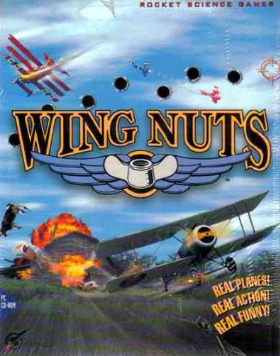
Wing Nuts: Battle in the Sky is a game published by BMG Interactive Entertainment and developed by Rocket Science Games for DOS in 1995.

PaTaank is a 1994 video game developed by PF.Magic for the 3DO.
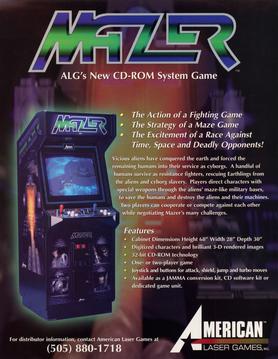
Mazer is a video game developed and published by American Laser Games in arcades as well as the 3DO.
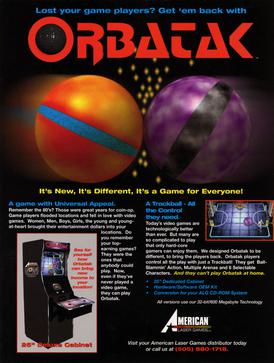
Orbatak is a video game developed and published by American Laser Games for the arcade. A 3DO Interactive Multiplayer version was announced but never released.

Varuna's Forces is an unreleased sci-fi video game that was in development by Accent Media Productions and planned to be published by Atari Corporation for the Atari Jaguar CD and JVC for 3DO Interactive Multiplayer, Dreamcast, PC, PlayStation and Sega Saturn.

Road Rash is a 1994 racing and vehicular combat video game originally published by Electronic Arts (EA) for the 3DO Interactive Multiplayer. A version for the Sega CD was developed simultaneously and released in 1995 to act as a "bridge" between the 3DO version and the Sega Genesis title Road Rash 3, and the game was subsequently ported to the PlayStation, Sega Saturn, and Microsoft Windows in 1996. The game is the third installment in the Road Rash series, and is centered around a series of motorcycle races throughout California that the player must win to advance to higher-difficulty races, while engaging in unarmed and armed combat to hinder the other racers.

















